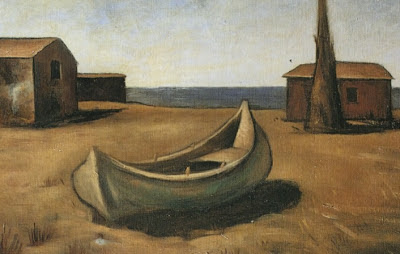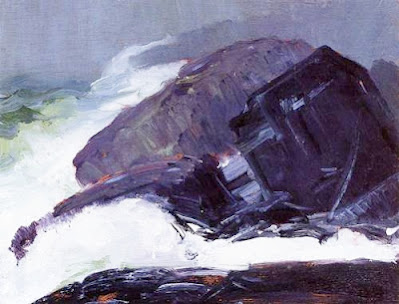Libro 1
Los delineamientos de los gigantes (4)
I (Continuación)
Si no era belleza, era una extrañeza y una audaz asociación de vida salvaje y vida culta que crecieron juntas en las Ramapos: dos fases.
En las colinas, donde la trucha común se deslizaba entre las piedras a poca profundidad, Ringwood —donde había estado la granja Ryerson— entre sus prados aterciopelados, rodeadas de árboles: el nogal blanco, el olmo, el olmo blanco, el castaño y la haya, los abedules, el tupelo, el liquidámbar, el cerezo silvestre y el arándano con su fruto pendiente.
Mientras las cabañas de los herreros se amontonaban en el bosque, los fogoneros, los que hornean la cal —ocultos para el hermoso Ringwood— donde el General Washington, embelleciendo cualquier poema llegado desde Pompton: un descanso luego de la ejecución del traidor para estar tranquilos —armando los eslabones de la gran cadena a través de Hudson en West Point.
La violencia estalló en Tennessee, la masacre de los indios, ahorcamientos y exilio —esperando, parados en el cadalso, sesenta de ellos. Los Tuscorora, forzados a abandonar su tierra, las Seis Naciones los invitaron a unirse a ellas en el norte de Nueva York. Los hombres iban al frente, pero algunas mujeres y rezagados no llegaron más allá del angosto valle cercano a Suffern. Se fueron a las montañas donde se les unieron los desertores hessianos del ejército británico; entre ellos, un grupo de albinos, esclavos negros que habían huido, y un montón de mujeres y sus niños liberados en Nueva York después de que los ingleses fueran obligados a retirarse. Allá, las tenían en la penitenciaría — un hombre llamado Jackson, contratado por el gobierno inglés para proveer de mujeres a los soldados norteamericanos, las levantó de Liverpool y otros lugares.
La mezcla se extendió por el bosque y fueron llamadas las blancas de Jackson por el general. (También hubo algunas negras, mezcladas, negras de las Antillas, una carga que reemplazó a las blancas que se perdieron cuando su barco, uno de los seis provenientes de Inglaterra, que se hundió en una tormenta en el mar. Debía compensarlo de algún modo y éste era el más rápido y económico).
La región se llamó Nueva Barbados.
Cromwell, a mediados del siglo diecisiete, embarcó unas miles de mujeres irlandesas y niños hacia Barbados para ser vendidas como esclavas. Obligadas por sus propietarios a acoplarse con los otros, estas desdichadas fueron sucedidas por algunas generaciones de negros y mulatos que hablaban irlandés. Y hoy día se dice comúnmente que los nativos de Barbados hablan con acento irlandés.
Recuerdo
una fotografía del
Geographic, las 9 mujeres
de algún jefe africano, semidesnudas
sentadas en un tronco, se supone un tronco
oficial, cabezas a la izquierda:
Primero
inmóvil la más joven y reciente,
derecha, una reina orgullosa, consciente de su poder,
tapada de barro, su cabello monumental
cayendo sobre las cejas —contraídas con violencia.
Detrás de ella, apretadas
en una escala descendiente de frescura
se tensaban las otras
y después . .
la última, la primera esposa,
¡presentes! aguantando todo el resto que crece
desde ella —cuyos ojos están intranquilos
serios, amenazantes—pero inmutable; pechos
caídos por el uso excesivo . .
Mientras que los pechos turgentes
de aquella otra, tensos, cargados de
presiones no liberadas
y expresando una pasión
evidente.
No es que los relámpagos
no atraviesen el misterio de un hombre
de punta a punta —y en el medio, no importa
cuánto tenga de jefe, sino sobre todo
por eso— para destruirlo en su casa
. . Femenina, una vaga sonrisa,
libre, flotando como una paloma
después de un largo vuelo hasta su nido.
La señora Sarah Cumming, consorte del reverendo Hopper Cumming, de Newark, era hija del difunto señor John Emmons, de Portland, en el distrito de Maine… Llevaba dos meses de casada, y fue bendecida con la perspectiva favorable de una infrecuente participación en la felicidad y utilidad Temporal en la esfera que la Providencia le había asignado; pero, oh, qué incierta es la continuidad de todo goce terrenal.
William Carlos Williams (Rutherford, 1883-1963),
Paterson, New Directions, New York, 1963
Versión de Silvia Camerotto
The delineaments of the giants I
If there was no beauty, there was a strangeness and a bold association of wild and cultured life grew up together in the Ramapos: two phases.// In the hills, where the brown trout slithered among the shallow stones, Ringwood —where the old Ryerson farm had been— among its velvet lawns, was ringed with forest trees, the butternut, and the elm, the white oak, the chestnut and the beech, the birches, the tupelo, the sweet-gum, the wild cherry and the hackleberry with its red tumbling fruit. //While in the forest clustered the ironworkers’ cabins, the charcoal burners, the lime kiln workers —hidden from lovely Ringwood— where General Washington, gracing any poem, up from Pompton for rest after the traitors’ hanging could be at ease —and the links were made for the great chain across the Hudson at West Point. // Violence broke out in Tennessee, a massacre by the Indians, hangings and exile —standing there on the scaffold waiting, sixty of them. The Tuscaroras, forced to leave their country, were invited by the Six Nations to join them in Upper New York. The bucks went on ahead but some of the women and the stragglers got no further than the valley-cleft near Suffern. They took to the mountains there where they were joined by Hessian deserters from the British Army, a number of albinos among them, escaped negro slaves and a lot of women and their brats released in New York City after the British had been forced to leave. They had them in a pen there—picked up in Liverpool and elsewhere by a man named Jackson under contract with the British Government to provide women for the soldiers in America. //The mixture ran in the woods and took the general name, Jackson’s Whites. (There had been some blacks also, mixed in, some West Indian negresses, a ship-load, to replace the whites lost when their ship, one of six coming from England, had foundered in a storm at sea. He had to make it up somehow and that was the quickest and cheapest way). //New Barbados Neck, the region was called. //Cromwell, in the middle of the seventeenth century, shipped some thousands of Irish women and children to the Barbados to be sold as slaves. Forced by their owners to mate with the others these unfortunates were succeeded by a few generations of Irish speaking negroes and mulattoes. And it is commonly asserted to this day the natives of Barbados speak with an Irish brogue. //I remember /a Geographic picture, the 9 women /of some African chief semi-naked /astraddle a log, an official log to /be presumed, heads left: //Foremost /froze the young and latest, /erect, a proud queen, conscious of her power, /mud-caked, her monumental hair /slanted above the brows —violently frowning. //Behind her, packed tight up /in a descending scale of freshness /stiffened the others//and then . . /the last, the first wife, /present! Supporting all the rest growing /up from her —whose careworn eyes /serious, menacing —but unabashed; breasts /sagging from hard use . . . //Whereas the uppointed breasts /of that other, tense, charged with /pressures unrelieved . /and the rekindling they bespoke /was evident. //Not that the lightnings /do not stab at the mystery of a man /from both ends —and the middle, no matter /how much a chief he may be, rather the more /because of it, to destroy him at home //. . Womanlike, a vague smile, /unattached, floating like a pigeon /after a long flight to his cote. // Mrs. Sarah Cumming, consort of the Rev. Hopper Cumming, of Newark, was a daughter of the late Mr. John Emmons, of Portland, in the district of Maine… She had been married about two months, and was blessed with a flattering prospect of no common share of Temporal felicity and usefulness in the sphere which Providence had assigned her; but oh, how uncertain is the continuance of every earthly joy.
Ilustración:
Totem Lesson, 1945, Jackson Pollock





























